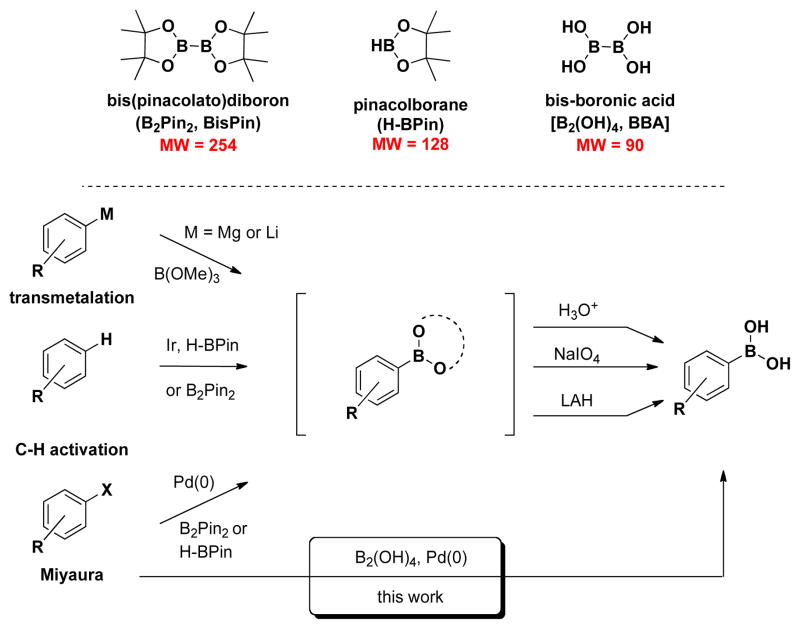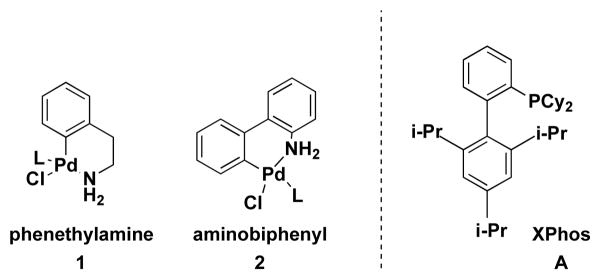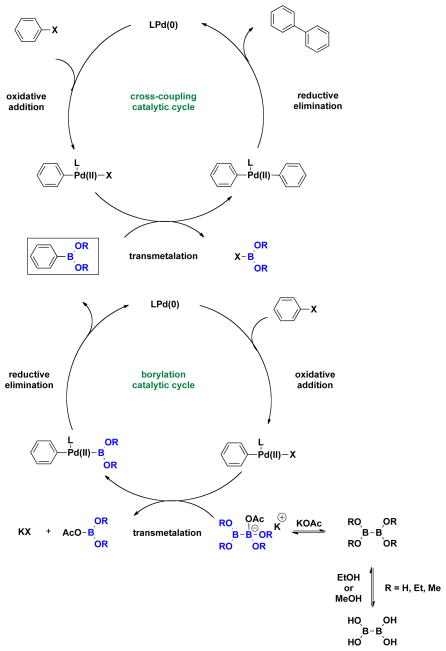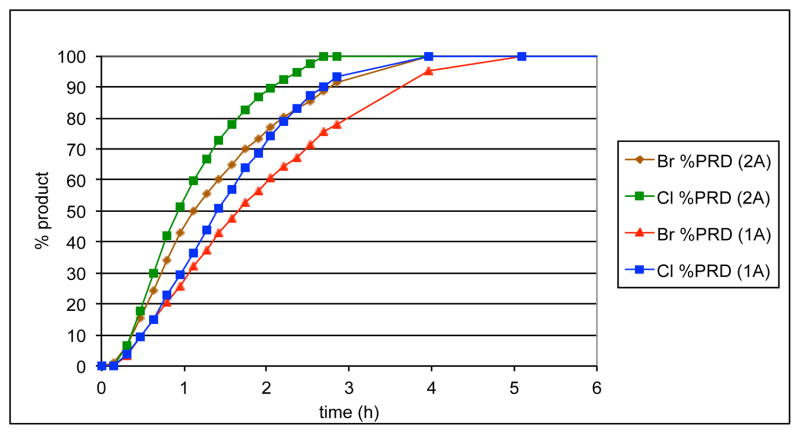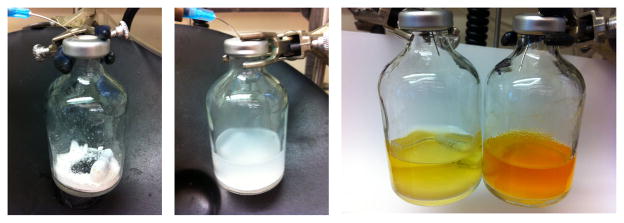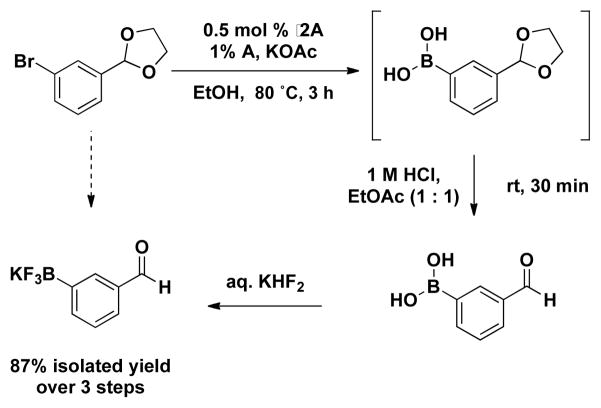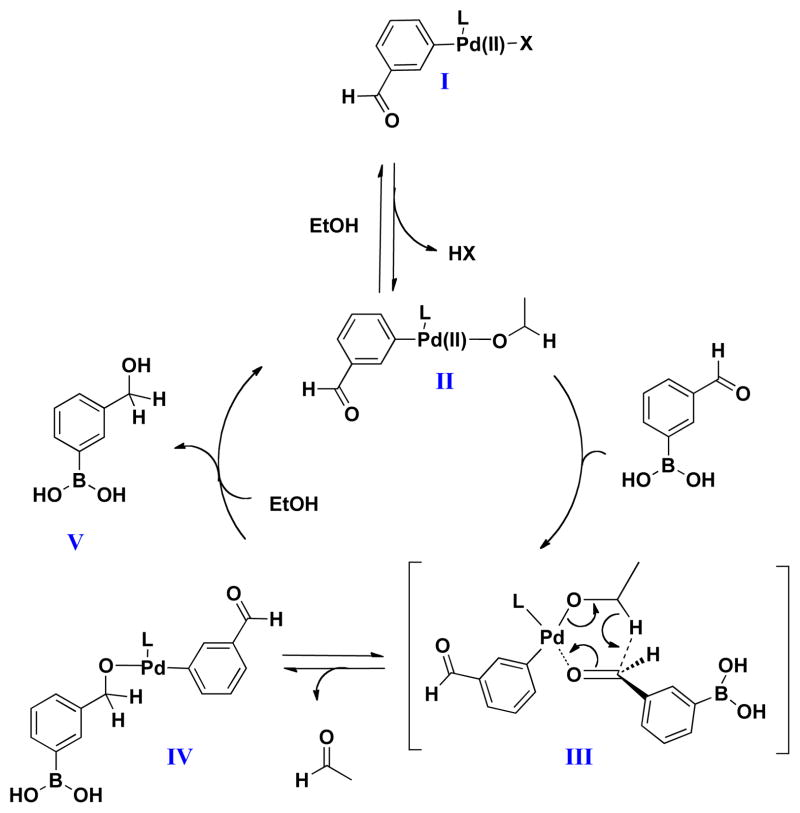Abstract
The Suzuki-Miyaura reaction has become one of the more useful tools for synthetic organic chemists. Until recently, there did not exist a direct way to make the most important component in the coupling reaction, namely the boronic acid. Current methods to make boronic acids often employ harsh or wasteful reagents to prepare boronic acid derivatives and require additional steps to afford the desired boronic acid. The scope of the previously reported palladium-catalyzed, direct boronic acid synthesis is unveiled, which includes a wide array of synthetically useful aryl electrophiles. It makes use of the newly available second generation Buchwald XPhos preformed palladium catalyst and bis-boronic acid (BBA). For ease of isolation and to preserve the often sensitive C-B bond, all boronic acids were readily converted to their more stable trifluoroborate counterparts.
Keywords: Boronic acid, catalysis, palladium, bis-boronic acid, tetrahydroxydiboron, Miyaura borylation
Introduction
The Suzuki-Miyaura cross-coupling (SMC) reaction has become one of the most widely applied methods in current synthetic organic chemistry.1,2 In fact, it is currently estimated that 25% of all reactions performed in the pharmaceutical industry consist of cross-coupling reactions, and among these, Suzuki coupling reactions play a major role.3–5 Most research in the area of SMC has been dedicated to improving substrate scope, lowering catalyst load, and reducing reaction time and temperatures using a variety of electrophiles, boronic acids and surrogates. Little effort, however, has been focused on the synthesis of the boronic acid partner itself even though other synthetically useful reactions such as the Chan-Lam coupling6 and the Petasis-Borono Mannich7 reactions also employ boronic acids.
The current state-of-the-art in the synthesis of boronic acids includes transmetalation via metal/halogen exchange or directed ortho metalation,8–10 C-H activation,11 or the palladium catalyzed Miyaura borylation.12–17 Although these methods supply the requisite boron species in reasonable yields, all current methods result in the formation of boronate esters, and require additional steps (acid hydrolysis,18–21 oxidation,22–25 or reduction26) to reveal the boronic acid if it is the required boron partner. Of greatest importance when applying these methods is the choice of borylating reagent. Although the transmetalation reactions utilize a relatively atom economical boron source (trialkyl borates), these protocols are extremely limited by functional group tolerability. By contrast, the C-H activation and Miyaura borylation methods utilize bis(pinacolato)diboron (B2Pin2) or pinacolborane (H-BPin)11–17 These reagents are more robust than most trialkyl borates, and the catalytic processes employing them are more functional group tolerant than transmetalation routes (Scheme 1).
Scheme 1.
Current Methods to Synthesize Boronic Acids.
However, by modern standards, B2Pin2 is an extremely wasteful reagent, dramatically reducing the efficiency of discovery and synthesis in both industrial and academic pursuits. Pinacol makes up >90% of the mass of B2Pin2. Because it is not an integral component of the final desired boronic acid partner and must be removed, pinacol is simply an unwanted byproduct of current borylation reactions. Given the current annual demand for B2Pin2, tons of pinacol are being used and disposed of needlessly each year. If the boronic acid is required, in addition to the unnecessary generation of waste, the resulting pinacol boronates are often challenging to hydrolyze. Additionally troublesome is the finding that pinacol, once released, is notoriously difficult to remove from reaction mixtures.27–30 Laborious extraction or distillation techniques are therefore required that further detract from the overall process efficiency.
Results and Discussion
We recently reported an efficient method to synthesize the boron coupling partner directly with a more atom economical reagent.31 This method represented the first direct synthesis of boronic acids from aryl halides, solving many of the problems associated with the use of B2Pin2 or H-BPin.
Our first report of this novel method focused on less expensive and more abundant aryl chlorides and demonstrated that the intermediate boronic acid obtained could be used to access various boronate esters and trifluoroborates, as well as cross-coupled products in a one-pot, two-step borylation-Suzuki sequence. It also demonstrated tolerance of a wide range of functional groups and proceeded with low catalyst loads (1 mol %) and bench stable reagents, eliminating the use of a glove box or anhydrous solvents. The key to the success of this process was the use of a relatively underutilized reagent, bis-boronic acid [BBA, referred to as tetrahydroxydiboron, B2(OH)4, Scheme 1]32,33 and Buchwald’s first generation XPhos phenethylamine preformed catalyst 1A (Figure 1).34 Through the course of high throughput experimentation (HTE), it was discovered that rapid and efficient Pd(0) catalyst formation was essential to protect BBA from the facile decomposition that occurs when it is exposed to Pd(II). The finding that the commercially available XPhos preformed catalyst 1A forms this requisite Pd(0) species rapidly in the presence of equimolar amounts of strong base (NaOt-Bu) at the reaction temperature (80 °C) greatly simplified the original optimized method, which involved heating Pd(OAc)2 in the presence of XPhos and KOAc in EtOH for 20 minutes at 80 °C before the addition of the aryl chloride and BBA in EtOH. Through the use of 1A, all reagents could simply be added to the reaction flask at the same time, with subsequent addition of EtOH and heating to conduct the reaction.
Figure 1.
Buchwald’s First (1) and Second (2) Generation Preformed Catalysts. XPhos (A) Ligand (L).
The first general method employing 1A was optimized on 4-chloroanisole. Through HTE it was preliminarily concluded that 1.5 equivalents of BBA was sufficient for the successful borylation of aryl chlorides, as 4-chloroanisole yielded the corresponding trifluoroborate in 90% yield with minimal homocoupling. However, during substrate scope exploration, the borylation of some aryl chlorides resulted in a significant amount of the homocoupled product. Mechanistically, it can be rationalized that the oxidative addition complex, once formed, can undergo a transmetalation with either BBA or the rapidly forming boronic acid (Scheme 2).35,36
Scheme 2.
Competing Catalytic Cycles
If sufficient BBA is supplied to the catalytic cycle, then the oxidative addition complex should preferentially react with BBA over the boronic acid. This is in fact what was experimentally observed. When three equivalents of BBA were used, yields improved, sometimes on the order of 20%. The use of excess borylating agent is not unique to this method and is common in reactions wherein B2Pin2 is employed.12
Interestingly, when 4-bromoanisole was subjected to the identical conditions optimized for 4-chloroanisole (utilizing 1.5 equivalents of BBA and 1), there was a significant amount of homocoupled and halide-reduction product observed. Kinetic experiments determined that 4-bromoanisole underwent the borylation at a rate 18% slower than 4-chloroanisole indicating that the transmetalation step was the rate limiting step of the process, and that the arylpalladium halide species represents the resting state of the catalyst (Figure 2). The more rapid oxidative addition of aryl bromides versus that of aryl chlorides permits a more rapid buildup of this intermediate, thereby providing sufficient time for it to react with the ever-increasing supply of the boronic acid being formed as opposed to the diminishing supply of BBA being consumed.
Figure 2.
Kinetics Experiments Comparing 4-Bromo and 4-Chloroanisole Under Reaction Conditions Using Catalyst 1A or 2A (Figure 1).
Shortly after the publication of the communication describing the work above, Buchwald et al. disclosed the synthesis and application of a second generation XPhos preformed catalyst 2A (Figure 1).37 This improved catalyst allows rapid formation of the requisite Pd(0) species at room temperature with a weak base, eliminating the need for additional strong base (NaOt-Bu). Additionally, the improved catalyst provides trifluorobo-rates in higher yields for every aryl chloride substrate examined in the original communication. (vida infra).
In this article, we disclose the full scope of the direct synthesis of boronic acids from a wide range of aryl electrophiles employing 2A as catalyst. This new method represents an improvement from the previous communication, as the general method proceeds efficiently with half the catalyst load (0.5 mol % Pd), with XPhos (3:1 ligand/palladium), KOAc (3 equiv), at 80 °C in EtOH with reaction times ranging from 1 to 9 hours. Although we have previously demonstrated the isolation of the boronic acid product, often it was difficult to obtain the pure crystalline form of these materials without some loss in yield. As this loss in yield did not accurately quantify the reaction conversion, crude boronic acids were immediately converted to the corresponding trifluoroborate (eq 1). Conversion to the crystalline trifluoroborate also ensures preservation of the C-B bond during prolonged bench storage. Additionally, the Soxhlet extraction technique used to purify the trifluoroborate salt is operationally simpler and potentially less wasteful than column chromatography, which is often required for purification of pinacol boronates when B2Pin2 is used.12
 |
(1) |
All reagents used in the improved method are commercially available and bench stable, eliminating the use of a glove box. Further, the use of degassed, non-anhydrous ethanol provides a green alternative to more common borylation methods utilizing ethereal solvents, often at high temperatures.12 Of great surprise and delight was our finding of a readily observable color change that occurs at the completion of all borylation reactions: the reactions uniformly change from colorless to yellow for the aryl chlorides and from colorless to orange for the aryl bromides, further facilitating analytical end-point analysis and ease of method execution (Figure 3).
Figure 3.
Color Change Indicating Completion of the Boryla-tion Reaction: left to right: air stable solids during degassing; colorless reaction solution; completion of reaction [aryl chlorides turn yellow (left), aryl bromides turn orange (right)].
The scope of the borylation with aryl chlorides is outlined in Table 1. In general, functional groups are well tolerated, affording the corresponding trifluoroborates in good to excellent yield after aqueous work-up and treatment with KHF2. For comparison, reported literature yields of pinacol boronates previously synthesized utilizing B2Pin2 in the Miyaura borylation are also included in the Tables throughout.12,38–41 In most cases, the yields are equivalent or superior to those of previously published results (Tables 1, 2, 4, and 6). As noted (vida infra) all of the trifluoroborates obtained with this improved method are accessed in higher yields than those reported previously in our communication.31 The reaction can also be run on a 12 mmol scale, allowing a dramatic reduction in both palladium (from 0.5 mol % to 0.1 mol %) and solvent (from 0.1 M in EtOH to 0.5 M) with almost no decrease in yield (Table 1, entry 5d). Although not as operationally simple, our original reaction procedure (prior to the discovery of the pre-formed catalyst 2A) can be performed very efficiently with less expensive Pd(OAc)2 (Table 1, entry 1a). In this protocol, before the addition of the pre-dissolved BBA (in EtOH) and substrate, 0.5 mol % of Pd(OAc)2, 1.5 mol % of XPhos, and KOAc (3 equiv) are stirred in EtOH for 20 min at 80 °C, activating the catalyst by reduction from Pd(II) to Pd(0). Without this preactivation, the Pd(OAc)2 decomposes BBA to boric acid almost instantaneously as monitored by 11B NMR.
Table 1.
Boronic Acid Synthesis from Aryl Chlorides and Conversion to Trifluoroborates
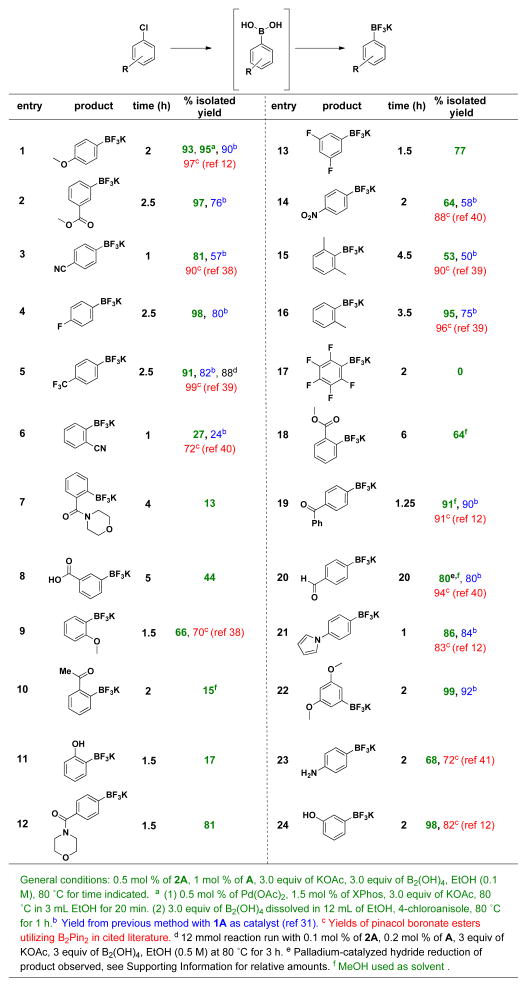
|
Table 2.
Boronic Acid Synthesis from Aryl Bromides and Conversion to Trifluoroborates
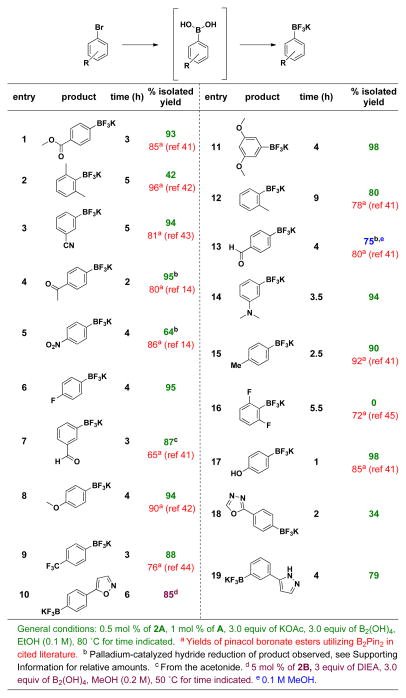
|
Table 4.
Boronic Acid Synthesis with Heteroaryl Halides
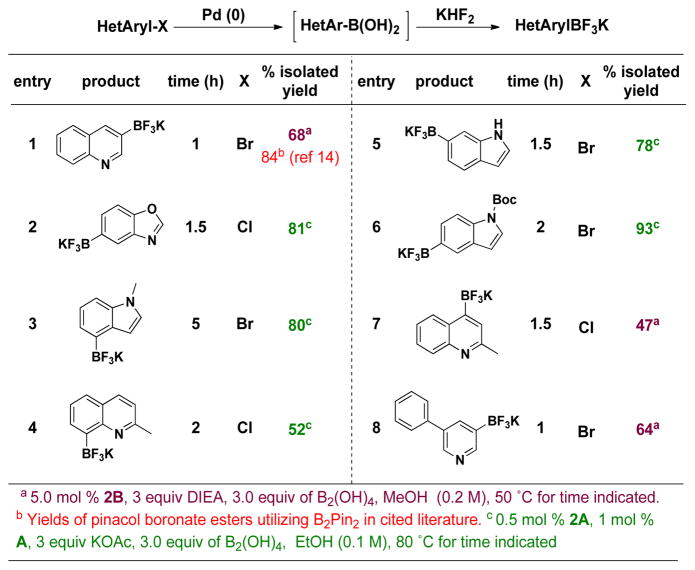
|
Table 6.
Electrophile Scope
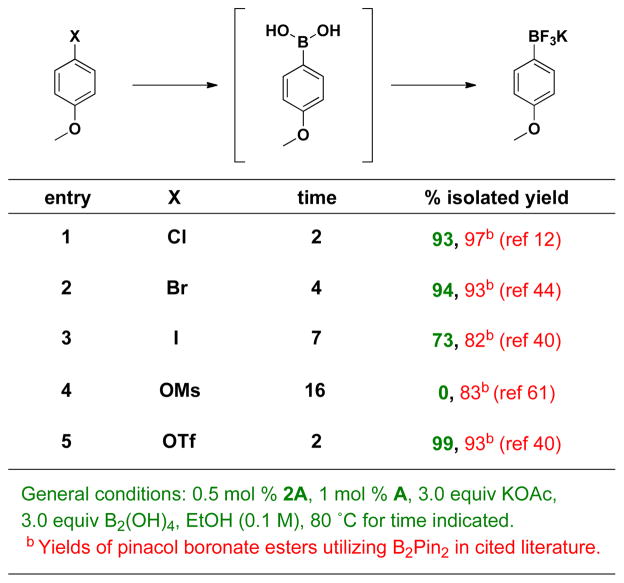
|
Sterically hindered substrates (mono- or disubstituted at the ortho positions) result in good to excellent yields (Table 1 entries 15 and 16). However, substrates with electron-withdrawing groups in this same position represent the only major limitation of the current method, leading to poor yields and mixtures of products in some cases (Table 1 entries 6, 7, 10 and 18). That these low yields are not due to protodeboronation by KHF2 was determined by quenching the reactions with pinacol, where equally low yields were observed. Interestingly, a hydroxyl group in this position also affords the product in only 17% yield (Table 1, entry 11), while the methyl ether in the same position leads to a reasonable yield of 66% (Table 1, entry 9). Although the reactions are run in ethanol, no transesterification occurs except in the case of the ortho methyl benzoate (Table 1, entry 18). This phenomenon can be avoided by running the reaction in MeOH with no apparent loss in yield.
Aryl bromides also perform well under the standard borylation conditions, performing better than their pinacol boronate counterparts in some instances (Table 2).14,41–45 In general, yields are slightly lower with the bromides as compared to the corresponding chlorides, and reaction times are slightly longer. It is believed that this increase in reaction time leads to more of the observed palladium-catalyzed hydride reduction side products in susceptible substrates. For example, the 4-nitro substituted chloride (Table 1, entry 14) undergoes full conversion in two hours with 7% reduction to the amine, while the corresponding bromide (Table 2, entry 5) requires 4 hours and leads to 20% reduction. In addition to the reduction of nitro groups, hydride reduction was also observed with ketones and aldehydes. The amount of reduction was decreased through the use of MeOH as solvent.46
With regard to the groups most affected by the palladium-catalyzed hydride reduction, aldehydes are by the far the most sensitive (Table 3), with reduction amounts ranging from 30% (Table 2, entry 13) to 66% (Table 1, entry 20) of the isolated product, depending on how long the reaction is heated (4 vs. 20 hours). This problem can, however, be avoided through the use of the acetonide (Table 2, entry 7), affording the aldehyde in 87% yield after simple deprotection of the boronic acid intermediate before converting to the trifluoroborate (Scheme 3).
Table 3.
Comparison of the Palladium-Catalyzed Hydride Reduction.
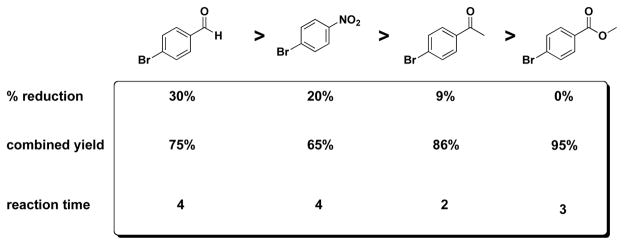
|
Scheme 3.
Aldehyde-Containing Trifluoroborate Synthesis.
A proposed mechanism for the observed palladium-catalyzed hydride reduction is outlined in Scheme 4. After oxidative addition of the aldehyde-containing aryl halide to Pd(0), the oxidative addition complex I is in equilibrium with the alcoholysis complex II, with EtOH adding selectively at the Pd-X bond.46,47 Acting as a Lewis acid, II activates the aldehyde carbonyl and delivers hydride via a six-membered transition state III, giving rise to complex IV.48 Alcoholysis of IV by EtOH leads to the formation of the reduced aldehyde V, regenerating the catalytically active species II.
Scheme 4.
Proposed Mechanism of Observed Palladium-Hydride Reduction of Aldehydes
Kinetic studies were also performed with 2A in the presence of 4-chloro- and 4-bromoanisole, and as expected, reaction times are faster with 2A as compared to 1A. As seen previously with 1A, 4-chloroanisole borylates at a rate 23% faster than the corresponding 4-bromoanisole (Figure 2) and 4-iodoanisole does not undergo full conversion under the general reaction conditions with 2A (vida infra). The borylation rate is therefore ArCl > ArBr > ArI. This rate order has been observed by Buchwald et al. in their SMC reactions utilizing 2A as catalyst wherein transmetalation was experimentally determined to be the rate-determining step,37 and in Stille coupling reactions.49 These relative rates have been ascribed to the electrophilicity of the intermediate organopalladium halides, which depend critically on the electronegativity of the halide component. Further studies demonstrated that the rate of the reaction of both 4-bromo- and 4-chloroanisole were decelerated with the addition of increasing amounts of bromide ions (in the form of n-Bu4NBr) to the reaction mixtures. The effect was more pronounced with 4-bromoanisole than with 4-chloroanisole.
The borylation was also extended to heteroaryl halides. As outlined in Table 4, for substrates with the heteroatom in the same ring as the halide (Table 4, entries 1, 7, and 8), a newly developed catalyst system was used. This system, with its structure and synthesis disclosed for the first time in this article (see Supporting Information), uses cataCXium A as the ligand (Figure 4). This complex was found to provide higher yields and faster reaction times than the XPhos-based 2A (Figure 1). These substrates required a higher catalyst load (5 mol %), lower reaction temperatures (50 °C), and DIEA as base. Additionally, MeOH was found to be a superior solvent to EtOH. Upon making the trifluoroborate of these substrates (Table 4, entries 1, 7 and 8), a mixture of the internal salt and potassium trifluoroborate salt were observed. To avoid this mixture and provide a quantifiable way to assess the yield, the compounds were subjected to a one-pot borylation/cross-coupling reaction (Table 5). No product could be isolated for heteroaryls with a halide in the 2-position.
Figure 4.
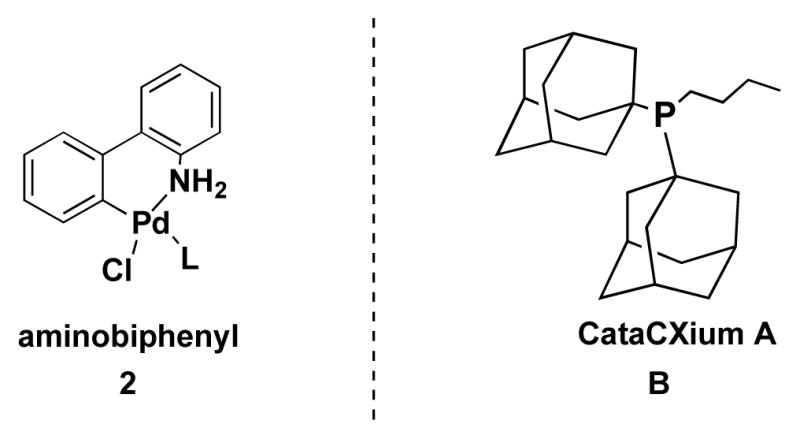
New Catalyst System for Heteroaryl Borylation
Table 5.
One-Pot Borylation/Cross-Coupling of Substrates Forming a Mixture of Internal and Trifluoroborate Salts
|
| |||||
|---|---|---|---|---|---|
| entry | starting halide | time (h) | second halide | product | % isolated yield |
| 1 |
|
1.5 |
|

|
64 |
| 2 |
|
5 |
|

|
60 |
| 3 |

|
1 |
|

|
68 |
One-pot borylation/Suzuki: 5 mol % 2B, 3 equiv DIEA, 3.0 equiv B2(OH)4, MeOH (0.2 M), 50 °C for time indicated. 3 equiv 1 M K3PO4, 1 equiv second halide. 50 °C, 15 h.
For those substrates with the heteroatom in the ring adjacent to the one bearing the halide, the general method applied to the regular aryl halides discussed (vida infra) worked remarkably well (Table 4). Most surprising was the stability of pyrazole, isoxazole, oxazole, and oxadiazole functional units under the prescribed conditions. Although many heteroaryl substrates were attempted, several failed to provide reasonable amounts of borylated product. This finding does not appear to be unique to this method. Through a thorough literature search of heteroaryl boronates synthesized from B2Pin2 or H-BPin, two trends can be found: either the method reported is purely for one functionalized heteroaryl,50–60 or only a few examples were synthesized under reaction conditions considered under a “general” methods procedure.14,40,42,44,61–64 Also noteworthy is that the heteroaryls examined in this search are among just a handful of heteroaryl borylated products that can be found in the literature, and there is no publication dedicated solely to the Miyaura borylation of heteroaryls using B2Pin2. Our findings, coupled with the literature results, provide evidence that a general method for the borylation of hetereoaryls remains elusive, and that each substrate or general class of substrates may need to be treated on a case-by-case basis. However, as demonstrated in Table 4, discovery of a method to borylate a particular substrate or class can likely be achieved rapidly through HTE.
Additionally, the two-step, one-pot borylation/Suzuki cross-coupling method we previously published offers a practical solution to many of the challenges associated with heteroaryl borylation (Table 5). The heteroaryl halides couple remarkably well as the electrophilic partner in the SMC reaction, including 2-substituted heteroaryl substrates. The full scope of this one pot process is the focus of current research.
The borylation method was also examined with other aryl electrophiles.12,40,44,61 Aryl iodides and triflates borylate in good to excellent yield (Table 6), while mesylates failed to give rise to any product under the conditions optimized for aryl chlorides. As expected, 4-iodoanisole did not perform as well as its chloro- and bromo counterparts. The reaction did not go to full conversion even after 7 hours of reaction time, and palladium was observed to precipitate from the reaction mixture.
Conclusions
In summary, the scope of the palladium-catalyzed direct borylation using bis-boronic acid has been explored. The method is effective with a wide range of functional groups with both chloro- and bromo-substituted aryls, providing easy access to the corresponding trifluoroborates in good to excellent yields. The method can also be extended to aryl iodides and triflates. Although heteroaryls remain a challenge, much progress has been made with respect to their borylation. All reagents used in the method are bench stable and commercially available. The use of exceedingly low catalyst loadings, employing ethanol as solvent, combined with the relatively benign side-products of the reaction, offer a greener, more economical method than those previously used to perform transition metal-catalyzed borylations. Further, all reactions undergo a readily observable color change at their completion, making the reactions easy to monitor. The major advantage of the method is that it allows practitioners to bypass the synthesis of atom inefficient boronate esters to access boronic acids directly, or to advance efficiently to the more stable aryltri-fluoroborates.
Supplementary Material
Acknowledgments
Funding Sources
The research described was supported by the NIGMS (R01 GM081376) and the NSF GOALI program. SLJT is supported by a Merck Doctoral Fellowship through the MRL Doctoral Program.
SLJT dedicates this paper to Dr. Joe Vacca. Nick Perrotto (Merck Process Chemistry) is acknowledged for his help in obtaining kinetics data and Rakesh Kohli (University of Pennsylvania) for his help in obtaining HRMS data. We thank BASF for a generous donation of BBA. We also thank Accerlyrs Library Studio and Virscidian Inc. Analytical Studio Professional.
ABBREVIATIONS
- BBA
bis-boronic acid
Footnotes
Author Contributions
The manuscript was written through contributions of all authors.
Supporting Information. All experimental details associated with the content of this manuscript. This material is available free of charge via the Internet at http://pubs.acs.org.
References
- 1.Bellina F, Carpita A, Rossi R. Synthesis. 2004:2419–2440. [Google Scholar]
- 2.Kotha S, Lahiri K, Kashinath D. Tetrahedron. 2002;58:9633–9695. [Google Scholar]
- 3.Carey JS, Laffan D, Thomson C, Williams MT. Org Biomol Chem. 2006;4:2337–2347. doi: 10.1039/b602413k. [DOI] [PubMed] [Google Scholar]
- 4.Dugger RW, Ragan JA, Ripin DHB. Org Proc Res Dev. 2005;9:253–258. [Google Scholar]
- 5.Cooper TWJ, Campbell IB, Macdonald SJF. Angew Chem, Int Ed. 2010;49:8082–8091. doi: 10.1002/anie.201002238. [DOI] [PubMed] [Google Scholar]
- 6.Qiao J, Lam P. Synthesis. 2011;6:829–856. [Google Scholar]
- 7.Candeias N, Montalbano F, Cal PMSD, Gois P. Chem Rev. 2010;110:6169–6193. doi: 10.1021/cr100108k. [DOI] [PubMed] [Google Scholar]
- 8.Suzuki A, Brown HC. Organic Syntheses via Boranes. Vol. 3 Aldrich Chemical Company; Milwakee, WI: 2003. [Google Scholar]
- 9.Leermann T, Leroux FR, Colobert F. Org Lett. 2011;13:4479–4481. doi: 10.1021/ol2016252. [DOI] [PubMed] [Google Scholar]
- 10.Alessi M, Larkin AL, Ogilvie KA, Green LA, Lai SLS, Snieckus V. J Org Chem. 2007;72:1588–1594. doi: 10.1021/jo0620359. [DOI] [PubMed] [Google Scholar]
- 11.Mkhalid IAI, Barnard JH, Marder TB, Murphy JM, Hartwig JF. Chem Rev. 2010;110:890–931. doi: 10.1021/cr900206p. [DOI] [PubMed] [Google Scholar]
- 12.Billingsley K, Barder T, Buchwald S. Angew Chem Int Ed. 2007;46:5359–5363. doi: 10.1002/anie.200701551. [DOI] [PubMed] [Google Scholar]
- 13.Billingsley KL, Buchwald SL. J Org Chem. 2008;73:5589–5591. doi: 10.1021/jo800727s. [DOI] [PMC free article] [PubMed] [Google Scholar]
- 14.Ishiyama T, Murata M, Miyaura N. J Org Chem. 1995;60:7508–7510. [Google Scholar]
- 15.Rosen B, Huang C, Percec V. Org Lett. 2008;10:2597–2600. doi: 10.1021/ol800832n. [DOI] [PubMed] [Google Scholar]
- 16.Moldoveanu C, Wilson D, Wilson C, Corcoran P, Rosen B, Percec V. Org Lett. 2009;11:4974–4977. doi: 10.1021/ol902155e. [DOI] [PubMed] [Google Scholar]
- 17.Moldoveanu C, Wilson D, Wilson C, Leowananwat P, Resmerita A, Lui C, Rosen B, Percec V. J Org Chem. 2010;75:5438–5452. doi: 10.1021/jo101023t. [DOI] [PubMed] [Google Scholar]
- 18.Jung ME, Lazarova TI. J Org Chem. 1999;64:2976–2977. doi: 10.1021/jo9902751. [DOI] [PubMed] [Google Scholar]
- 19.Song YL, Morin C. Synlett. 2001:266–268. [Google Scholar]
- 20.Ma D, Wu Q. Tetrahedron Lett. 2001;42:5279–5281. [Google Scholar]
- 21.Zaidlewicz M, Wolan A. J Organomet Chem. 2002:129–135. [Google Scholar]
- 22.Nakamura H, Fujiwara M, Yamamoto Y. J Org Chem. 1998;63:7529–7530. doi: 10.1021/jo980818r. [DOI] [PubMed] [Google Scholar]
- 23.Yu S, Saenz J, Srirangam JK. J Org Chem. 2002;67:1699–1702. doi: 10.1021/jo016131f. [DOI] [PubMed] [Google Scholar]
- 24.Falck JR, Bondlela M, Venkataraman SK. J Org Chem. 2001;66:7148–7150. doi: 10.1021/jo015838z. [DOI] [PubMed] [Google Scholar]
- 25.Deng H, Jung JK, Liu T, Kuntz KW, Snapper ML, Hoveyda AH. J Am Chem Soc. 2003;125:9032–9034. doi: 10.1021/ja030249r. [DOI] [PubMed] [Google Scholar]
- 26.Yang W, He H, Drueckhammer DG. Angew Chem Int Ed. 2001;40:1714–1718. [PubMed] [Google Scholar]
- 27.Bagutski V, Ros A, Aggarwal VK. Tetrahedron. 2009;65 [Google Scholar]
- 28.Pennington T, Kardiman C, Hutton C. Tetrahedron Lett. 2004;45:6657–6660. [Google Scholar]
- 29.Yuen A, Hutton C. Tetrahedron Lett. 2005;46:7899–7903. [Google Scholar]
- 30.Sun J, Perfetti MT, Santos WL. J Org Chem. 2011;76:571–3575. doi: 10.1021/jo200250y. [DOI] [PMC free article] [PubMed] [Google Scholar]
- 31.Molander GA, Trice SLJ, Dreher SD. J Am Chem Soc. 2010;132:17701–17703. doi: 10.1021/ja1089759. [DOI] [PMC free article] [PubMed] [Google Scholar]
- 32.Selander N, Kipke A, Sebelius S, Szabo K. J Am Chem Soc. 2007;129:13723–12731. doi: 10.1021/ja074917a. [DOI] [PubMed] [Google Scholar]
- 33.Selander N, Szabo K. Chem Commun. 2008:3420–3422. doi: 10.1039/b804920c. [DOI] [PubMed] [Google Scholar]
- 34.Biscoe MR, Fors BP, Buchwald SL. J Am Chem Soc. 2008;130:6686–6687. doi: 10.1021/ja801137k. [DOI] [PMC free article] [PubMed] [Google Scholar]
- 35.Takahashi K, Ishiyama T, Miyaura N. J Organomet Chem. 2001;625:47–53. [Google Scholar]
- 36.Pubill-Ulldemolins C, Bonet A, Bo C, Gulyas H, Fernandez E. Chem Eur J. 2012;18:1121–1126. doi: 10.1002/chem.201102209. [DOI] [PubMed] [Google Scholar]
- 37.Kinzel T, Zhang Y, Buchwald SL. J Am Chem Soc. 2010;132:14073–14075. doi: 10.1021/ja1073799. [DOI] [PMC free article] [PubMed] [Google Scholar]
- 38.Fürstner A, Seidel G. Org Lett. 2002;4:541–543. doi: 10.1021/ol0171463. [DOI] [PubMed] [Google Scholar]
- 39.Kawamorita S, Ohmiya H, Iwai T, Sawamura M. Angew Chem Int Ed. 2011;50:8363–8366. doi: 10.1002/anie.201103224. [DOI] [PubMed] [Google Scholar]
- 40.Ishiyama T, Ishida K, Miyaura N. Tetrahedron. 2001;57:9813–9816. [Google Scholar]
- 41.Lu J, Guan Z, Gao J, Zhang Z. Appl Organometal Chem. 2011;25:537–541. [Google Scholar]
- 42.Tang W, Keshipeddy S, Zhang Y, Wei X, Savoie J, Patel ND, Yee NK, Senanayake CH. Org Lett. 2011;13:1366–1369. doi: 10.1021/ol2000556. [DOI] [PubMed] [Google Scholar]
- 43.Zhu Z, Duquette J, Zhang M. J Org Chem. 2003;68:3729–3732. doi: 10.1021/jo0269114. [DOI] [PubMed] [Google Scholar]
- 44.Wang L, Li J, Cui X, Wu Y, Zhu Z, Wu Y. Adv Synth Catal. 2010;352:2002–2010. [Google Scholar]
- 45.Chotana GA, Rak MA, Smith MRI. J Am Chem Soc. 2005;127:10539–10544. doi: 10.1021/ja0428309. [DOI] [PubMed] [Google Scholar]
- 46.Lin S, Lu X. Org Lett. 2010;12:2536–2539. doi: 10.1021/ol100767u. [DOI] [PubMed] [Google Scholar]
- 47.Liu C, Tang S, Liwei Z, Liu D, Zhang H, Lei A. Angew Chem Int Ed. 2012:1–6. [Google Scholar]
- 48.Nakamura H, Ishikura M, Sugiishi T, Kamakura T, Biellmann JF. Org Biomol Chem. 2008;6:1471–1477. doi: 10.1039/b718298h. [DOI] [PubMed] [Google Scholar]
- 49.Casada A, Espinet P. J Am Chem Soc. 1998;120:8978–8985. [Google Scholar]
- 50.Schnuerch M, Hammerle J, Mihovilovic MD, Stanetty P. Synthesis. 2010;5:837–843. [Google Scholar]
- 51.Morgentin R, Jung F, Lamorlette M, Maudet M, Menard M, Pasquest G, Renaud F. Tetrahedron. 2009;65:757–764. [Google Scholar]
- 52.Germain H, Harris CS, Renaud F, Warin N. Synthetic Commun. 2009:523–530. [Google Scholar]
- 53.Bondoux M, Mignon L, Ou K, Renaut D, Barberousse V. Tetrahedron Lett. 2009;50:3872–3876. [Google Scholar]
- 54.Larson KK, Sarpong R. J Am Chem Soc. 2009;131:13244–13245. doi: 10.1021/ja9063487. [DOI] [PubMed] [Google Scholar]
- 55.Martin T, Laguerre C, Hoarau C, Marsais F. Org Lett. 2009;11:3690–3693. doi: 10.1021/ol901525t. [DOI] [PubMed] [Google Scholar]
- 56.Leblanc Y, Cerat P. Synth Commun. 2008;38:2775–2781. [Google Scholar]
- 57.Araki H, Katoh T, Inoue M. Tetrahedron Lett. 2007;48:3713–3717. [Google Scholar]
- 58.Clapham KM, Smith A, Batsanov AS, McIntyre L, Pountney A, Bryce MR, Tarbit B. Eur J Org Chem. 2007;34:5712–5716. [Google Scholar]
- 59.Araki H, Katoh T, Inoue M. Synlett. 2006;4:555–558. [Google Scholar]
- 60.Paul S, Chotana GA, Holmes D, Reichle RC, Maleczka RE, Smith MRI. J Am Chem Soc. 2006;128:15552–15553. doi: 10.1021/ja0631652. [DOI] [PubMed] [Google Scholar]
- 61.Chow WK, So CM, Lau CP, Kwong FY. Chem Eur J. 2011;17:6913–6917. doi: 10.1002/chem.201100361. [DOI] [PubMed] [Google Scholar]
- 62.Lee Y, Kelly M. Tetrahedron Lett. 2006;47:4897–4901. [Google Scholar]
- 63.Murphy JM, Tzschucke CC, Hartwig JF. Org Lett. 2007;9:757–760. doi: 10.1021/ol062903o. [DOI] [PubMed] [Google Scholar]
- 64.Billingsley Kl, Buchwald SL. J Org Chem. 2008;73:5589–5591. doi: 10.1021/jo800727s. [DOI] [PMC free article] [PubMed] [Google Scholar]
Associated Data
This section collects any data citations, data availability statements, or supplementary materials included in this article.



